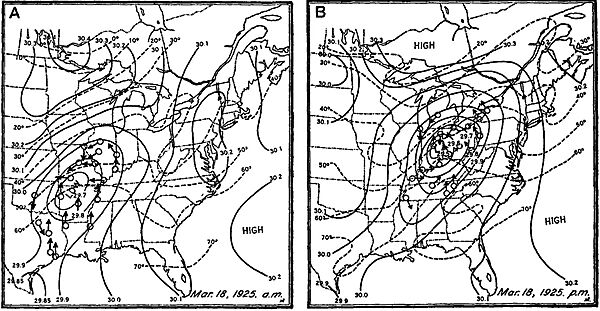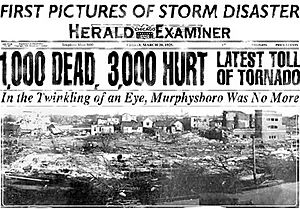1925 Tri-State tornado facts for kids
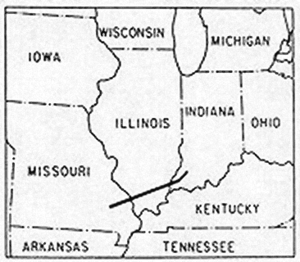
The path of the Tri-State tornado
|
|
| Meteorological history | |
|---|---|
| Duration | 3 hours, 45 minutes |
| Formed | March 18, 1925 12:45 p.m. CST (UTC−06:00) Reynolds County, Missouri |
| Dissipated | March 18, 1925 4:30 p.m. CST (UTC−06:00) Pike County, Indiana |
| Unofficial F5 tornado | |
| Path length | 219 miles (352 km) (disputed; see #Understanding the Tri-State Tornado) |
| Highest winds | >300 mph (480 km/h) |
| Overall effects | |
| Fatalities | 695 (Root 1926, Changnon et al 1971, current accepted figure). 689 (originally listed by the Weather Bureau). Actual number likely greater than either figure. The Weather Bureau page from Barron lists 742 dead. |
| Injuries | At least 2,027 (most sources). 2,756 (Barron and Root) |
| Damage | $16.55 million (1925 USD); $2.9 billion (2024 USD) (3rd-costliest in U.S. history) |
| Areas affected | Southern Missouri, Illinois, Indiana |
|
Part of the Tri-State tornado outbreak and Tornadoes of 1925 |
|
On Wednesday, March 18, 1925, a powerful and historic tornado swept through parts of eastern Missouri, southern Illinois, and southern Indiana. This event, often called the Tri-State tornado, was the deadliest tornado in United States history. It caused immense destruction and tragically affected many lives across three states.
The tornado was part of a larger severe weather outbreak that day. It left a path of catastrophic damage through numerous towns and rural areas. Although it was not officially rated at the time, experts widely agree it was an F5 tornado. This is the highest rating on the Fujita scale, meaning its winds likely exceeded 300 miles per hour (480 km/h).
Contents
The Great Tri-State Tornado of 1925
The tornado first touched down in Shannon County, Missouri, around 12:45 p.m. It moved quickly northeast, causing immediate and severe damage. The town of Annapolis was one of the first places hit hard, with about 90% of its buildings destroyed. Many people were injured there.
The Tornado's Destructive Path
Across Missouri
After Annapolis, the tornado continued its destructive journey through Bollinger County. It struck two schools, injuring several children who were taking shelter. In some areas, the ground was deeply scoured, meaning the powerful winds tore up the soil. Debris from towns was found almost 50 miles (80 km) away. The tornado then hit other small communities like Brazeau and Frohna. In total, at least 12 people lost their lives in Missouri.
Through Illinois
The tornado then crossed the Mississippi River into southern Illinois, causing even more widespread devastation. At 2:30 p.m., it directly hit the town of Gorham. More than half of Gorham's population was injured or lost their lives, and the town was almost completely destroyed.
Moving northeast at an average speed of 62 miles per hour (100 km/h), the tornado carved a path nearly 1 mile (1.6 km) wide through Murphysboro. This was a busy coal shipping and railroad town of 10,000 people. The tornado leveled most of the town, especially densely populated neighborhoods. Many homes were swept away, trees were stripped of their bark, and vehicles were thrown several blocks. Tragically, schools were also devastated, and many students were lost. After the tornado passed, large fires broke out, making the situation even more difficult for survivors. Murphysboro experienced a tragic loss of life, with 234 people eventually dying from the storm's impact. This is the highest death toll for any single city in U.S. history from a tornado.
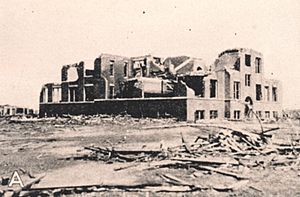
The tornado then struck De Soto, which was almost completely destroyed. Tragically, many students were lost when the De Soto School partially collapsed. The tornado continued to devastate farms and small villages, including Bush, where homes were leveled and heavy railroad axles were scattered.
Next, the tornado entered Franklin County, narrowly missing some towns but devastating rural areas. It then hit the large mining town of West Frankfort. Here, many neighborhoods, businesses, and mining operations were severely damaged. A large coal tipple, weighing hundreds of tons, was blown over. The storm claimed 102 lives in West Frankfort. The small mining village of Caldwell was obliterated, and the town of Parrish was so completely destroyed that it was never rebuilt.
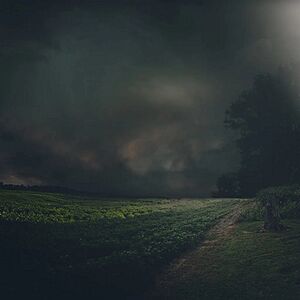
The tornado continued across Hamilton and White counties. In Hamilton County, the tornado reached its greatest width, about 1.5 miles (2.4 km) wide. Dozens of farms, homes, schools, and churches were swept away. In Illinois, the tornado caused the loss of 588 lives.
Into Indiana
Crossing the Wabash River, the tornado entered Indiana. It completely demolished the town of Griffin, where almost every building was damaged or swept away. Tragically, 46 people died in Griffin and the surrounding areas.
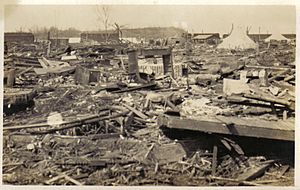
The tornado then roared into the factory town of Princeton, destroying much of its southern side. A Heinz factory was badly damaged. The tornado finally dissipated around 4:30 p.m. CST in Pike County, over three hours after it first touched down. In Indiana, at least 95 people lost their lives.
What Caused This Powerful Tornado?
On March 18, 1925, the weather conditions were perfect for a massive tornado outbreak. A strong low-pressure system formed over the central United States. This system pulled warm, moist air from the Gulf of Mexico northward. At the same time, cooler, drier air moved in from the west.
When these different air masses met, they created a very unstable atmosphere. This instability, combined with strong winds at different heights, set the stage for powerful thunderstorms. These storms could then produce tornadoes. The Tri-State supercell, the thunderstorm that created this tornado, formed in a highly favorable area where these different air masses converged.
After the Storm: Recovery and Impact
The Tri-State tornado was the deadliest in U.S. history. It tragically took the lives of 695 people and injured thousands more. Hospitals in nearby cities quickly became overwhelmed with those needing help. Relief efforts began immediately, with trains carrying injured people to larger hospitals. Communities rallied together to support the survivors. Many people were left without homes or food, and fires broke out in some areas, adding to the destruction.
The recovery process was slow, and the event left a lasting impact on the region. The storm's final victim passed away on January 3, 1926, from injuries sustained in the tornado. In total, 12 people died in Missouri, 95 in Indiana, and 588 in Illinois. The tornado affected three states, 14 counties, and more than 19 communities. Approximately 15,000 homes were destroyed. The total damage was estimated at $16.5 million in 1925, which would be about $2.9 billion in 2024.
Fifty-seven schools across the three states were damaged or destroyed. Tragically, 90 people, mostly students, were lost. This was the highest number of schools destroyed and students lost in any single tornadic event in U.S. history. About one-third of all the tornado's victims were children.
Legacy of the Tri-State Tornado
The devastating Tri-State tornado changed how people thought about tornadoes. Before this event, some people believed tornadoes were a form of divine punishment. However, after the Tri-State tornado, many ministers stated that the tornado was not divine punishment, helping people understand natural disasters differently.
The famous painting Tornado over Kansas by John Steuart Curry (1929) is believed to have been inspired by the Tri-State tornado.
Understanding the Tri-State Tornado
Interestingly, no known photos or videos exist of the Tri-State tornado. Witnesses often described it as a "rolling fog" or "boiling clouds" on the ground. This unusual appearance, combined with heavy rain and dust, made it hard for people to recognize the danger until it was too late. The weather leading up to the tornado was also unusual, with cool temperatures and morning rain, which was not what people expected before such a powerful storm.
Modern meteorologists estimate that the tornado's wind speeds topped 300 miles per hour (480 km/h) in some places. At one point in Missouri, it was a full 1.5 miles (2.4 km) wide. The tornado also had very strong accompanying winds, called downbursts, which sometimes made the damage path even wider, up to 3 miles (4.8 km) across.
There has been a long debate among scientists about whether the Tri-State tornado was a single, continuous tornado or a series of tornadoes from the same storm. A single tornado lasting for such a long time (over 3.5 hours) and covering such a long distance (219 miles or 352 km) is very rare.
Recent research in 2013 suggested that while some parts of the path might have been separate tornadoes, a significant portion, possibly 151 to 174 miles (243 to 280 km), was likely from one continuous tornado. This would still make it one of the longest-tracked tornadoes ever recorded. The tornado's fast forward motion, averaging 59 miles per hour (95 km/h), helped it cover such a vast distance.
See also
 In Spanish: Tornado triestatal de 1925 para niños
In Spanish: Tornado triestatal de 1925 para niños


